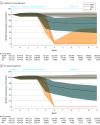Comparative Effectiveness of Opioid Tapering or Abrupt Discontinuation vs No Dosage Change for Opioid Overdose or Suicide for Patients Receiving Stable Long-term Opioid Therapy
- PMID: 35960518
- PMCID: PMC9375167
- DOI: 10.1001/jamanetworkopen.2022.26523
Comparative Effectiveness of Opioid Tapering or Abrupt Discontinuation vs No Dosage Change for Opioid Overdose or Suicide for Patients Receiving Stable Long-term Opioid Therapy
Abstract
Importance: Opioid dosage tapering has emerged as a strategy to reduce harms associated with long-term opioid therapy; however, evidence supporting this approach is limited.
Objective: To identify the association of opioid tapering or abrupt discontinuation with opioid overdose and suicide events among patients receiving stable long-term opioid therapy without evidence of opioid misuse.
Design, setting, and participants: This comparative effectiveness study with a trial emulation approach used a large US claims data set of individuals with commercial insurance or Medicare Advantage who were aged 18 years or older and receiving stable long-term opioid therapy without evidence of opioid misuse between January 1, 2010, and December 31, 2018. Statistical analysis was performed from January 17, 2020, through November 12, 2021.
Interventions: Three opioid dosage strategies: stable dosage, tapering (dosage reduction ≥15%), or abrupt discontinuation.
Main outcomes and measures: Time to opioid overdose or suicide event identified from International Classification of Diseases, Ninth Revision and International Statistical Classification of Diseases and Related Health Problems, Tenth Revision diagnosis codes in medical claims over 11 months of follow-up. Inverse probability weighting was used to adjust for baseline confounders. The primary analysis used an intention-to-treat approach; follow-up after assignment regardless of changes in opioid dose was included. A per-protocol analysis was also conducted, in which episodes were censored for lack of adherence to assigned treatment.
Results: A cohort of 199 836 individuals (45.1% men; mean [SD] age, 56.9 [12.4] years; and 57.6% aged 45-64 years) had 415 123 qualifying, long-term opioid therapy episodes; 87.1% of episodes were considered stable, 11.1% were considered a taper, and 1.8% were considered abrupt discontinuation. The adjusted cumulative incidence of opioid overdose or suicide events 11 months after baseline was 0.96% (95% CI, 0.92%-0.99%) with a stable dosage strategy, 1.10% (95% CI, 0.99%-1.22%) with a tapered dosage strategy, and 1.28% (95% CI, 0.93%-1.38%) with an abrupt discontinuation strategy. The risk difference between a taper and a stable dosage was 0.15% (95% CI, 0.03%-0.26%), and the risk difference between abrupt discontinuation and a stable dosage was 0.33% (95% CI, -0.03% to 0.74%). Results were similar using the per-protocol approach.
Conclusions and relevance: This study identified a small absolute increase in risk of harms associated with opioid tapering compared with a stable opioid dosage. These results do not suggest that policies of mandatory dosage tapering for individuals receiving a stable long-term opioid dosage without evidence of opioid misuse will reduce short-term harm via suicide and overdose.
Conflict of interest statement
Figures



Similar articles
-
Benzodiazepine Discontinuation and Mortality Among Patients Receiving Long-Term Benzodiazepine Therapy.JAMA Netw Open. 2023 Dec 1;6(12):e2348557. doi: 10.1001/jamanetworkopen.2023.48557. JAMA Netw Open. 2023. PMID: 38117495 Free PMC article.
-
Long-term Risk of Overdose or Mental Health Crisis After Opioid Dose Tapering.JAMA Netw Open. 2022 Jun 1;5(6):e2216726. doi: 10.1001/jamanetworkopen.2022.16726. JAMA Netw Open. 2022. PMID: 35696163 Free PMC article.
-
Association of Opioid Dose Reduction With Opioid Overdose and Opioid Use Disorder Among Patients Receiving High-Dose, Long-term Opioid Therapy in North Carolina.JAMA Netw Open. 2022 Apr 1;5(4):e229191. doi: 10.1001/jamanetworkopen.2022.9191. JAMA Netw Open. 2022. PMID: 35476064 Free PMC article.
-
Assessing Variation in State Opioid Tapering Laws: Comparing State Laws with the CDC Guideline.Pain Med. 2021 Dec 11;22(12):2941-2949. doi: 10.1093/pm/pnab208. Pain Med. 2021. PMID: 34196723 Review.
-
Benefits and Harms of Long-term Opioid Dose Reduction or Discontinuation in Patients with Chronic Pain: a Rapid Review.J Gen Intern Med. 2020 Dec;35(Suppl 3):935-944. doi: 10.1007/s11606-020-06253-8. Epub 2020 Nov 3. J Gen Intern Med. 2020. PMID: 33145689 Free PMC article.
Cited by
-
Predictors of fatal and nonfatal overdose after prescription of opioids for chronic pain: a systematic review and meta-analysis of observational studies.CMAJ. 2023 Oct 23;195(41):E1399-E1411. doi: 10.1503/cmaj.230459. CMAJ. 2023. PMID: 37871953 Free PMC article.
-
Association Between Opioid Use Disorder and Healthcare Spending and Utilization in Emergency Surgical Patients: A Retrospective Analysis Using Commercial Claims.Ann Surg Open. 2025 Apr 10;6(2):e568. doi: 10.1097/AS9.0000000000000568. eCollection 2025 Jun. Ann Surg Open. 2025. PMID: 40557352 Free PMC article.
-
Problems accessing pain care, and the adverse outcomes among adults with chronic pain: a cross-sectional survey study.Pain Manag. 2025 Feb;15(2):81-91. doi: 10.1080/17581869.2025.2463865. Epub 2025 Feb 12. Pain Manag. 2025. PMID: 39936847 Free PMC article.
-
Care Models to Improve Pain and Reduce Opioids Among Patients Prescribed Long-Term Opioid Therapy: The VOICE Randomized Clinical Trial.JAMA Intern Med. 2025 Feb 1;185(2):208-220. doi: 10.1001/jamainternmed.2024.6683. JAMA Intern Med. 2025. PMID: 39652356 Clinical Trial.
-
Benzodiazepine Discontinuation and Mortality Among Patients Receiving Long-Term Benzodiazepine Therapy.JAMA Netw Open. 2023 Dec 1;6(12):e2348557. doi: 10.1001/jamanetworkopen.2023.48557. JAMA Netw Open. 2023. PMID: 38117495 Free PMC article.
References
Publication types
MeSH terms
Substances
LinkOut - more resources
Full Text Sources
Medical

